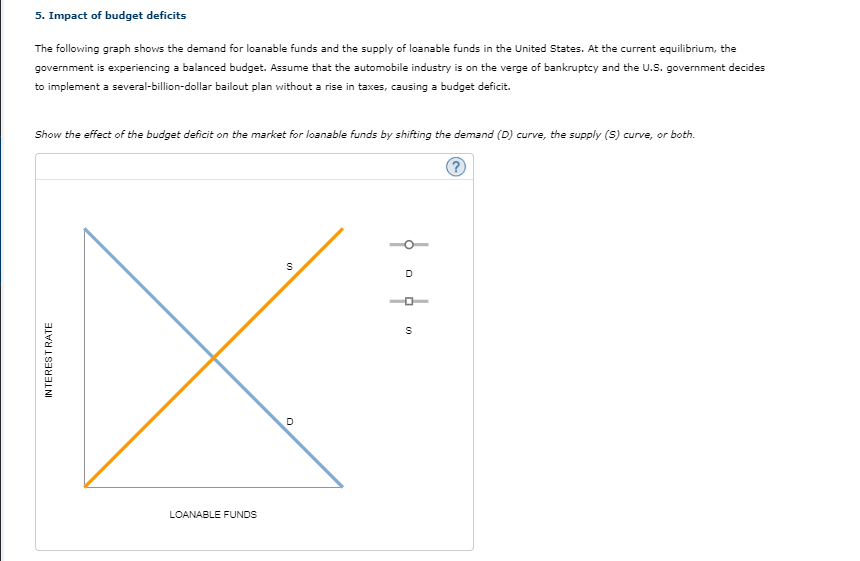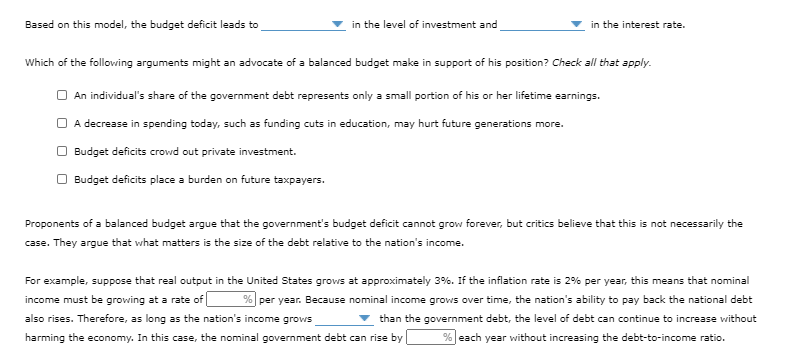5. Impact of budget deficits The following graph shovs the demand for loanable funds and the supply of loanable funds in the United States. At the current equilibrium, the government is experiencing a balanced budget. Assume that the automobile industry is on the verge of bankruptcy and the U.S. government decides to implement a several-billion-dollar bailout plan without a rise in taxes, causing a budget deficit. Show the effect of the budget deficit on the market for loanable funds by shifting the demand (D) curve, the supply (S) curve, or both.
5. Impact of budget deficits The following graph shovs the demand for loanable funds and the supply of loanable funds in the United States. At the current equilibrium, the government is experiencing a balanced budget. Assume that the automobile industry is on the verge of bankruptcy and the U.S. government decides to implement a several-billion-dollar bailout plan without a rise in taxes, causing a budget deficit. Show the effect of the budget deficit on the market for loanable funds by shifting the demand (D) curve, the supply (S) curve, or both.
Essentials of Economics (MindTap Course List)
8th Edition
ISBN:9781337091992
Author:N. Gregory Mankiw
Publisher:N. Gregory Mankiw
Chapter18: Savings,investment And The Financial System
Section: Chapter Questions
Problem 9PA
Related questions
Question
Impact of budget deficits

Transcribed Image Text:5. Impact of budget deficits
The following graph shows the demand for loanable funds and the supply of loanable funds in the United States. At the current equilibrium, the
government is experiencing a balanced budget. Assume that the automobile industry is on the verge of bankruptcy and the U.S. government decides
to implement a several-billion-dollar bailout plan without a rise in taxes, causing a budget deficit.
Show the effect of the budget deficit on the market for loanable funds by shifting the demand (D) curve, the supply (S) curve, or both.
LOANABLE FUNDS
IN TEREST RATE

Transcribed Image Text:Based on this model, the budget deficit leads to
in the level of investment and
in the interest rate.
Which of the following arguments might an advocate of a balanced budget make in support of his position? Check all that apply.
O An individual's share of the government debt represents only a small portion of his or her lifetime earnings.
O A decrease in spending today, such as funding cuts in education, may hurt future generations more.
O Budget deficits crowd out private investment.
O Budget deficits place a burden on future taxpayers.
Proponents of a balanced budget argue that the government's budget deficit cannot grow forever, but critics believe that this is not necessarily the
case. They argue that what matters is the size of the debt relative to the nation's income.
For example, suppose that real output in the United States grovws at approximately 3%. If the inflation rate is 2% per year, this means that nominal
income must be growing at a rate of
% per year. Because nominal income grows over time, the nation's ability to pay back the national debt
also rises. Therefore, as long as the nation's income grows
v than the government debt, the level of debt can continue to increase vwithout
harming the economy. In this case, the nominal government debt can rise by
% each year without increasing the debt-to-income ratio.
Expert Solution
This question has been solved!
Explore an expertly crafted, step-by-step solution for a thorough understanding of key concepts.
This is a popular solution!
Trending now
This is a popular solution!
Step by step
Solved in 2 steps with 1 images

Knowledge Booster
Learn more about
Need a deep-dive on the concept behind this application? Look no further. Learn more about this topic, economics and related others by exploring similar questions and additional content below.Recommended textbooks for you

Essentials of Economics (MindTap Course List)
Economics
ISBN:
9781337091992
Author:
N. Gregory Mankiw
Publisher:
Cengage Learning

Brief Principles of Macroeconomics (MindTap Cours…
Economics
ISBN:
9781337091985
Author:
N. Gregory Mankiw
Publisher:
Cengage Learning

Principles of Economics 2e
Economics
ISBN:
9781947172364
Author:
Steven A. Greenlaw; David Shapiro
Publisher:
OpenStax

Essentials of Economics (MindTap Course List)
Economics
ISBN:
9781337091992
Author:
N. Gregory Mankiw
Publisher:
Cengage Learning

Brief Principles of Macroeconomics (MindTap Cours…
Economics
ISBN:
9781337091985
Author:
N. Gregory Mankiw
Publisher:
Cengage Learning

Principles of Economics 2e
Economics
ISBN:
9781947172364
Author:
Steven A. Greenlaw; David Shapiro
Publisher:
OpenStax

Exploring Economics
Economics
ISBN:
9781544336329
Author:
Robert L. Sexton
Publisher:
SAGE Publications, Inc

Principles of Economics (MindTap Course List)
Economics
ISBN:
9781305585126
Author:
N. Gregory Mankiw
Publisher:
Cengage Learning

Principles of Economics, 7th Edition (MindTap Cou…
Economics
ISBN:
9781285165875
Author:
N. Gregory Mankiw
Publisher:
Cengage Learning